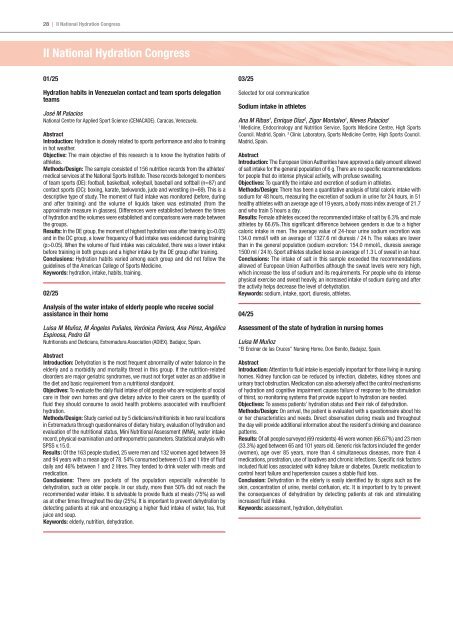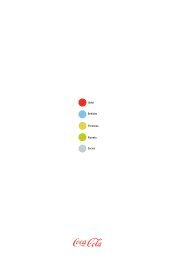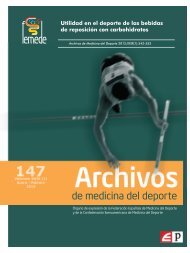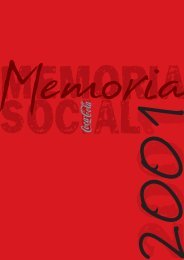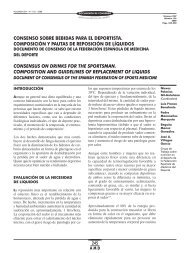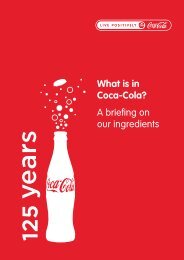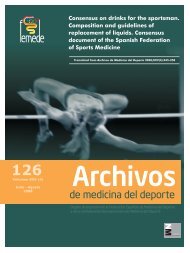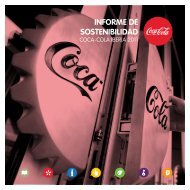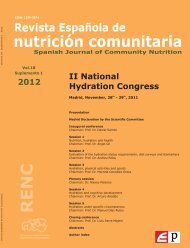II National Hydration Congress - Coca-Cola
II National Hydration Congress - Coca-Cola
II National Hydration Congress - Coca-Cola
Create successful ePaper yourself
Turn your PDF publications into a flip-book with our unique Google optimized e-Paper software.
28 | <strong>II</strong> <strong>National</strong> <strong>Hydration</strong> <strong>Congress</strong><strong>II</strong> <strong>National</strong> <strong>Hydration</strong> <strong>Congress</strong>01/25<strong>Hydration</strong> habits in Venezuelan contact and team sports delegationteamsJosé M Palacios<strong>National</strong> Centre for Applied Sport Science (CENACADE). Caracas, Venezuela.AbstractIntroduction: <strong>Hydration</strong> is closely related to sports performance and also to trainingin hot weather.Objective: The main objective of this research is to know the hydration habits ofathletes.Methods/Design: The sample consisted of 156 nutrition records from the athletes’medical services at the <strong>National</strong> Sports Institute. These records belonged to membersof team sports (DE): football, basketball, volleyball, baseball and softball (n=87) andcontact sports (DC): boxing, karate, taekwondo, judo and wrestling (n=69). This is adescriptive type of study. The moment of fluid intake was monitored (before, duringand after training) and the volume of liquids taken was estimated (from theapproximate measure in glasses). Differences were established between the timesof hydration and the volumes were established and comparisons were made betweenthe groups.Results: In the DE group, the moment of highest hydration was after training (p>0.05)and in the DC group, a lower frequency of fluid intake was evidenced during training(p>0.05). When the volume of fluid intake was calculated, there was a lower intakebefore training in both groups and a higher intake by the DE group after training.Conclusions: <strong>Hydration</strong> habits varied among each group and did not follow theguidelines of the American College of Sports Medicine.Keywords: hydration, intake, habits, training.02/25Analysis of the water intake of elderly people who receive socialassistance in their homeLuisa M Muñoz, M Ángeles Puñales, Verónica Periera, Ana Pérez, AngélicaEspinosa, Pedro GilNutritionists and Dieticians, Extremadura Association (ADIEX). Badajoz, Spain.AbstractIntroduction: Dehydration is the most frequent abnormality of water balance in theelderly and a morbidity and mortality threat in this group. If the nutrition-relateddisorders are major geriatric syndromes, we must not forget water as an additive inthe diet and basic requirement from a nutritional standpoint.Objectives: To evaluate the daily fluid intake of old people who are recipients of socialcare in their own homes and give dietary advice to their carers on the quantity offluid they should consume to avoid health problems associated with insufficienthydration.Methods/Design: Study carried out by 5 dieticians/nutritionists in two rural locationsin Extremadura through questionnaires of dietary history, evaluation of hydration andevaluation of the nutritional status, Mini Nutritional Assessment (MNA), water intakerecord, physical examination and anthropometric parameters. Statistical analysis withSPSS v.15.0.Results: Of the 163 people studied, 25 were men and 132 women aged between 39and 94 years with a mean age of 78. 54% consumed between 0.5 and 1 litre of fluiddaily and 46% between 1 and 2 litres. They tended to drink water with meals andmedication.Conclusions: There are pockets of the population especially vulnerable todehydration, such as older people. In our study, more than 50% did not reach therecommended water intake. It is advisable to provide fluids at meals (75%) as wellas at other times throughout the day (25%). It is important to prevent dehydration bydetecting patients at risk and encouraging a higher fluid intake of water, tea, fruitjuice and soup.Keywords: elderly, nutrition, dehydration.03/25Selected for oral communicationSodium intake in athletesAna M Ribas 1 , Enrique Díaz 2 , Zigor Montalvo 1 , Nieves Palacios 11Medicine, Endocrinology and Nutrition Service, Sports Medicine Centre, High SportsCouncil. Madrid, Spain. 2 Clinic Laboratory, Sports Medicine Centre, High Sports Council.Madrid, Spain.AbstractIntroduction: The European Union Authorities have approved a daily amount allowedof salt intake for the general population of 6 g. There are no specific recommendationsfor people that do intense physical activity, with profuse sweating.Objectives: To quantify the intake and excretion of sodium in athletes.Methods/Design: There has been a quantitative analysis of total caloric intake withsodium for 48 hours, measuring the excretion of sodium in urine for 24 hours, in 51healthy athletes with an average age of 19 years, a body mass index average of 21.7and who train 5 hours a day.Results: Female athletes exceed the recommended intake of salt by 6.3% and maleathletes by 66.6%.This significant difference between genders is due to a highercaloric intake in men. The average value of 24-hour urine sodium excretion was134.0 mmol/l with an average of 1327.6 ml diuresis / 24 h. The values are lowerthan in the general population (sodium excretion: 154.0 mmol/L, diuresis average1500 ml / 24 h). Sport athletes studied loose an average of 1.3 L of sweat in an hour.Conclusions: The intake of salt in this sample exceeded the recommendationsallowed of European Union Authorities although the sweat levels were very high,which increase the loss of sodium and its requirements. For people who do intensephysical exercise and sweat heavily, an increased intake of sodium during and afterthe activity helps decrease the level of dehydration.Keywords: sodium, intake, sport, diuresis, athletes.04/25Assessment of the state of hydration in nursing homesLuisa M Muñoz“El Encinar de las Cruces” Nursing Home. Don Benito, Badajoz, Spain.AbstractIntroduction: Attention to fluid intake is especially important for those living in nursinghomes. Kidney function can be reduced by infection, diabetes, kidney stones andurinary tract obstruction. Medication can also adversely affect the control mechanismsof hydration and cognitive impairment causes failure of response to the stimulationof thirst, so monitoring systems that provide support to hydration are needed.Objectives: To assess patients’ hydration status and their risk of dehydration.Methods/Design: On arrival, the patient is evaluated with a questionnaire about hisor her characteristics and needs. Direct observation during meals and throughoutthe day will provide additional information about the resident’s drinking and clearancepatterns.Results: Of all people surveyed (69 residents) 46 were women (66.67%) and 23 men(33.3%) aged between 65 and 101 years old. Generic risk factors included the gender(women), age over 85 years, more than 4 simultaneous diseases, more than 4medications, prostration, use of laxatives and chronic infections. Specific risk factorsincluded fluid loss associated with kidney failure or diabetes. Diuretic medication tocontrol heart failure and hypertension causes a stable fluid loss.Conclusion: Dehydration in the elderly is easily identified by its signs such as theskin, concentration of urine, mental confusion, etc. It is important to try to preventthe consequences of dehydration by detecting patients at risk and stimulatingincreased fluid intake.Keywords: assessment, hydration, dehydration.


